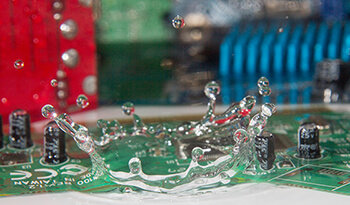What Really Kills Electronics, Water or Corrosion?

Posted on March 2nd, 2021 by Ryan Moore
Device failure. It happens to people every day. You may drop your phone in water, but it doesn’t necessarily stop working–at least not immediately. A common reaction (aside from wailing and gnashing of teeth) is to remove the battery, stick the phone in rice, and wait impatiently for it to dry out. As many of you may have experienced, this doesn’t always work.
What people don’t know is that in most cases simply drying your phone out is not a solution because water ingress isn’t the real problem. It’s corrosion. Corrosion begins almost instantly when an electronic device gets wet, and is typically what causes devices to fail.
However, all liquid is not the same when it comes to the impact it has on electronics after exposure. Other liquids like dirty dishwater, sports drinks, soda or the ocean pose a greater risk. While pure water doesn’t possess the electrolytes that damage devices, other drinks and liquids that contain a higher level of minerals are capable of conducting electricity. In other words, the further away you get from pure water, the more reason you have to worry.
Corrosion is the Real Enemy
The inside of every device has traces (wired connections between your device’s components) made of copper, which carry the electrical currents that power your phones, tablets, smart watches or other devices. When you expose those electronics to a liquid with electrolytes, it starts an instant flow of electricity between the traces. This wears down the original traces or creates new traces that shouldn’t exist. The wear down is the pull off of copper oxide, which you see in the form of green build up, similar to what you might find on a car battery connection.
There are two main types of corrosion that cause a device to fail.
1. Galvanic Corrosion: This is where the electrolytes in a liquid pull off enough copper oxide to break a trace and stop feeding electricity to the right locations.
2. Dendritic Corrosion: This form of corrosion occurs between two traces, pulling the copper out of one trace and creating an entirely new one.
Dendritic corrosion is more complex in nature than galvanic as the reaction itself is actually capable of rerouting a connection. Since a newly formed connection no longer pulls from the right trace source, a device stops working altogether or certain functionality is lost. This is often the case in battery failure. You may have experienced this type of deterioration if you’ve got your device wet. While it doesn’t fail instantly after exposure, over time the battery slowly loses charging capability. Eventually, it will die completely as the device will not being able to pull enough power from the new trace.
Learn More About Corrosion Protection
Lucky for the team at HZO, all of our products are waterproof and corrosion-resistant. One of HZO’s Senior Technicians, Nate Gold, dunks devices on a daily basis as part of his job analyzing and validating products. He recently found his personal phone at the bottom of a soapy sink full of dishes, courtesy of his two-year-old daughter. It’s one of the few times he’s experienced a submersion test that he hadn’t done intentionally, but in the end, the only inconvenience he suffered from the 45-minute device bath was a few missed calls.
That’s the beauty and power of HZO Protection. Our organic coating is a pinhole-free barrier that offers complete water and protection. HZO’s team of engineers are one click away from helping you create a waterproof and corrosion-proof device. Help your customers eliminate the stress of device failure by stopping it before it starts. Click here to start the conversation.
 Ryan Moore
Ryan Moore
Ryan is a 9-year veteran to the world of protecting electronics from harsh environments and a lover of all things technology.
Related
Discover how HZO can protect your product
